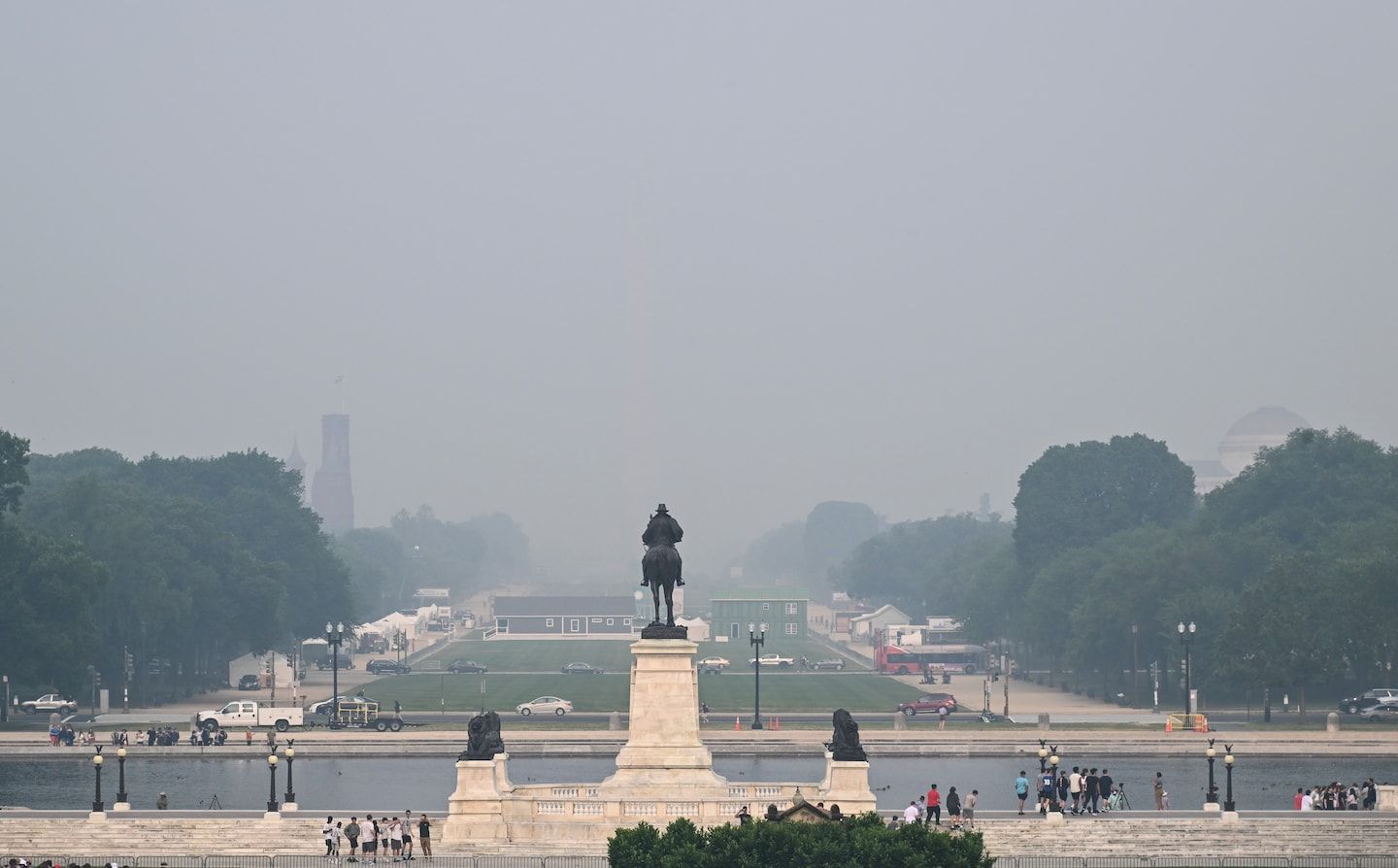How parents can protect children amid hazardous air quality, wildfire smoke
Lifestyle How parents can protect children amid hazardous air quality, wildfire smoke Wildfire smoke hangs over Washington on Thursday. (Ricky Carioti/The Washington Post)
Listen 8 min Comment on this story Comment Gift Article Share
An amber haze of smoke from Canadian wildfires has blanketed the Northeast United States in recent days, with hazardous air alerts issued all along the East Coast. The unprecedented conditions have left many families trying to figure out how to protect their kids amid an air quality crisis: How much time outside is okay? How dangerous is wildfire smoke for children? What if a child has asthma?
We spoke to Lisa Patel, a pediatrician and executive director of the Medical Society Consortium on Climate and Health, about what parents should know. The following interview has been edited for length and clarity.
Q: Can children be outside right now at all?
A: The data that we have on wildfire smoke is really concerning. The current guidelines we have are the Air Quality Index color blocks, indicating when you should spend most of your time inside or be fully inside, and then when it’s okay to spend some time outside. But with wildfires, we are really just figuring this out now, because wildfires didn’t used to happen this frequently. The data shows that wildfire smoke is 10 times as toxic to children compared to the pollution that the Air Quality Index was built off of — so if it’s a Code Orange day, or even a yellow day, I think this merits an additional degree of caution. For as long as these wildfires are burning, please stay inside as much as possible. You shouldn’t completely stop all the activities that you need for your daily living, but if there’s an option to leave your child in a safe space with cleaner air to breathe while you go out and run errands, I would encourage that. I worry particularly about kids under the age of 5, because that’s a period of very rapid lung development and kids breathe faster than adults, so, pound for pound, they’re breathing in more of that pollution than adults.
Advertisement
Q: Should children avoid time outside entire if air quality is Code Red or higher? What about Code Yellow?
A: The formal guidance says it’s okay to be outside when the Air Quality Index is in the yellow. Some balance there is okay, but from the way the data is emerging, I would absolutely not treat it like a normal day.
To me, the most important thing is to limit your time outside. Go get a little outdoor time in that yellow zone, because we do need to balance a child’s mental and physical health. Let your kid be a kid. With the caveat that we don’t have any formal guidance around this, I’ll speak to what I did as a parent: We would go outside a couple of times a day for about 30 minutes and play on the playground, and then come back inside.
Q: Should children wear masks?
A: I think when there is wildfire smoke in the air, it’s prudent to wear a mask, since we don’t fully yet know what the harms of exposure will be for children, and a mask is a low-effort intervention.
Advertisement
Q: What precautions are necessary for kids who have asthma?
A: I treat a lot of kids who come in with asthma flares when wildfires happen, so the general guidance I give those families is that if they have a controller medication, and it’s typically for when an asthmatic child has colds, I would recommend to start those controller medications now to stop a bad flare from happening. Parents should be in close contact with their pediatrician. Most kids have an asthma care plan, and if they’re having to take more medication than what’s in their ‘green zone,’ that’s a reason to follow up with their pediatrician and see if they need a higher degree of therapy. I would also consider wearing a mask, particularly if they do have to go outside on these really poor air quality days.
Q: Is it safe for children to ride in the car?
Advertisement
A: You can actually improve the inside air quality of your car by running the recirculate button for your car, and that does make that air in transport safer for kids.
Q: Should families use air purifiers at home?
A: Yes, I recommend investing in an air purifier. The product specifications will typically say the area that the air purifier can cover, so if you make sure that you have a rough sense of how big your room is, you can make sure that the air purifier is the right power to be able to clean that room. If cost is an issue, choose a smaller room where you can get away with a smaller air purifier, and make that the clean room in the home.
Q: How can you improve the air quality in your home if you can’t afford air purifiers?
A: I work with a lot of families who are on public insurance, so I do share resources for how to make a DIY air purifier for about $20, with a box fan and a HEPA filter.
Advertisement
There are other basic steps too: Close the windows. Try not to use a gas stove because we know gas stoves have really foul indoor air quality as well. Avoid vacuuming, avoid burning other things in the house like incense or candles that could make the air quality worse.
Q: What are the warning signs that a kid has been exposed to wildfire smoke?
A: Most people typically complain of burning eyes, or a burning feeling in their nose or throat. These are pretty noxious things that we’re breathing from wildfire smoke. If it progresses to chest tightness, a cough where it looks like your child is having trouble breathing — either they’re breathing fast, or using their belly muscles to breathe, or for an infant, they might be bobbing their heads to breathe or grunting because they’re really trying to open their airways — those would be concerning signs that your child is in respiratory distress, where they need to be seen by a provider. Also, if there’s audible wheezing, you should bring them in.
Advertisement
Q: How do we calm any anxiety children might have about these wildfires and smoke?
A: What I always tell parents is, first, let’s check in with ourselves. This is scary. Our kids are very perceptive, so if they perceive your stress, then they will be stressed too. I always start by asking my kids what they’ve seen, what they feel, what they understand. And once you hear from them about how they’re conceptualizing what’s going on around them, I access my kids’ feelings first. Not their knowledge, but their feelings — how they’re feeling about the fact that the sky is orange, and we talk through that. What I say to them is, ‘Our climate is changing because we burn fossil fuels; we are going to see more wildfires like this, but mommy and daddy are keeping you safe by keeping you inside.’ And a parent can also say, ‘I’m trying to make this better by doing X, Y and Z. We are driving an electric vehicle. We are turning off the lights when we don’t need them.’ Show your children you are part of the solution, and as your children get older, bring them into being part of the solution as well.
Q: How do we keep children from going stir-crazy? Can we get a temporary suspension of screen time rules?
Advertisement
A: Oh, I really empathize. In 2020, this happened to us during the pandemic. My husband and I created different activity stations. We would circulate the kids around the stations. We did a lot of reading, and we would also stop and do some screen time. When you do screen time, sit down and watch with your kids. Screen time is the worst when we just use it as a babysitter, but it’s actually pretty great when you sit down and enjoy a show with your kid and interact with them while you watch. That’s not detrimental to their development, to use screen time that way.
To parents who don’t have the privilege of doing this: Survive as you need to. A couple of days of screen time is not going to break the bank. Do what you need to do for the mental health and well-being of your family.
Q: Is there anything else that you think parents should know about these wildfires?
Advertisement
A: I’m passionate about this: I hope the silver lining from all this is that we have a greater understanding that climate change is going to affect all of us. I encourage every parent who is worried for their kids to realize that we have solutions, but we need more parents, more people involved in the climate movement to move us off fossil fuels and toward renewable energy. Because this isn’t the future that our kids should be living, and if more people don’t get involved, this is the future that our children will be living.
Source: The Washington Post


